

Tamron 90mm f2.8 Di VC USD Macro Review
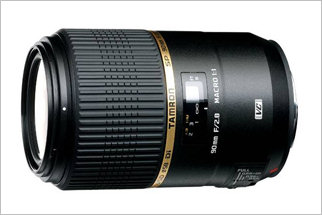
Tamron 90mm f2.8 Di VC USD Macro
Tamron 90mm macro lenses have long had an excellent reputation. The latest version (introduced in late 2012) is the Tamron SP 90mm f2.8 Di VC USD Macro. The new lens has many features including:
- Optical Stabilization (VC = Vibration Control)
- An ultrasonic drive AF motor (USD) with full time manual focusing control
- Improved sealing against dust and moisture
- Additional elements including two XLD (extra low dispersion) and one LD (low dispersion)
- Internal focusing
- eBAND coating
- Circular 9 blade aperture
Tamron 90mm f2.8 Di VC USD Macro Specifications
| Model | F004 |
| Lens Construction (Groups/Elements) | 11/14 |
| Angle of View (diagonal) | 27°02’ (full frame) 17°37’ (APS-C) |
| Aperture Range | f2.8 – f32 |
| Maximum Macro Magnification Ratio | 1:1 |
| Minimum Focusing Distance | 0.3m (11.8 in) |
| Working Distance at 1:1 macro | 139mm (5.5 in) |
| Filter Diameter | 58mm |
| Weight | 550g (19.4 oz) |
| Lens Length | 114.5mm (4.5 in) |
| Lens iameter | 76.4mm |
| Aperture Blades | 9 (circular) |
| Supplied Accessories | Lens hood |
| Available Mounts | Canon Nikon Sony (No VC) |
The Tamron 90mm f2.8 Di VC USD Macro is a Di series lens, meaning that it is designed to provide full frame coverage. It can, of course, also be used on crop sensor cameras where it provides the angle of view that a 135mm would on full frame. The lens is available in Canon, Nikon and Sony lens mounts, but the Sony version is not optically stabilized since Sony DSLRs use an in-body sensor shift system to stabilize the image.
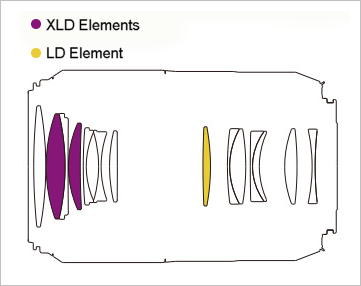
The Tamron SP 90MM F/2.8 Di VC USD 1:1 Macro has a semi-matte finish plastic outer barrel with a wide ruberrized focusing ring towards the front. There's an AF/MF switch, though since the lens has full time manual focusing the switch only has to be moved to the MF position when no AF operation is desired. The lens has three focusing ranges:
- Infinity to 0.3m
- Infinity to 0.5m
- 0.5m to 0.3m
The Vibration control system (VC) only has two settings, "on" and "off". There are no selectable panning modes.
In common with most Tamron lenses, the focus ring rotates to the left (anticlockwise looking from the rear) to get to close focus and to the right to get to infinity. This is also the usual scheme for Nikon lenses, but is backwards from the way most Canon lenses focus. It's not a problem, but it's something to be aware of.
The Tamron 90mm f2.8 Di VC USD Macro comes supplied with a lens hood and carries a 6 year warranty from Tamron.
Lens Performance
Focusing
The USD AF motor is fast and very quiet. I measured the time taken to focus from closest focus (0.3m) to infinity (or vice versa) in good light on an EOS 7D at around 0.55s. If the focus limiting switch is set to 0.5m to infinity, the time is reduced significantly to 0.22s, so you can see that if you aren't shooting in the macro range it pays to use the focus limiter.
Of course normally the lens just moves from wherever it's focused to the new focus point without cycling through the range. Cycling through the full range only happens if there's some initial focus difficulty, such as might occur in very low light. Normally focus is fast, quiet and positive.

AF works well all the way from infinity and normal focus distance down to 1:1 macro at 0.3m
Vibration Control
The Tamron VC system is effective. At normal focus distances most shots taken at around 1/10s were pretty sharp, which corresponds to around 3 stops of stabilization.
It's important to note that stabilization in the macro range is less effective than at non-macro focus distances. This is true for all simple stabilization systems which compensate for rotation about the horizontal and vertical axes. When the lens is focused down into the macro range, horizontal and vertical translation become important and most (but not all) stabilization systems don't compensate for much movement. Tamron themselves say that “From 3m, the benefits of VC gradually decrease as the focus distance becomes closer”. The Canon hybrid AF system can compensate for horizontal and vertical displacement.
The reason why horizontal and vertical translation becomes important in the macro range is simple. The amount that the image moves on the sensor when the camera is translated by "N" mm is simply "N" x magnification. so at 1:1 (1x magnification), is the camera is moved 1mm, the image also moves 1mm. If the lens is focused at a more normal distance, say 9000mm or 9m (29.5ft) the magnification is approximately 1/100 or 0.01x. If the camera moves 1mm, the image only moves by 1/100 mm
Sharpness at non-macro distances
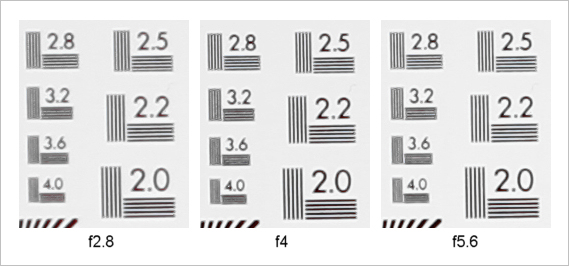
100% crops from image center, shot using EOS 7D
As you would expect, the Tamron 90mm f2.8 Di VC USD Macro is a sharp lens. Wide open at f2.8 it's very good in the center of the frame and good, but slightly less sharp, in the corners of a full frame image. If you look really closely stopping down marginally improves things and center sharpness probably peaks around f5.6, with the corners showing further improvement all the way though f11.
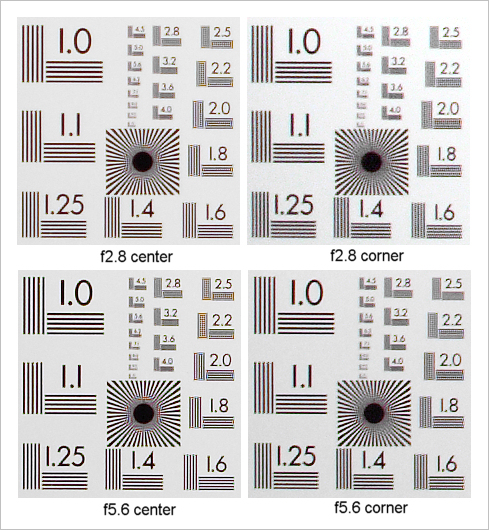
100% crops from EOS 5D
The images above are 100% crops from test shots with a full frame EOS 5D showing the center and corner sharpness at f2.8 and f5.6. The only processing done to the images was to compensate for the vignetting in order to make the crops easier to compare. It's pretty evident that the lens starts out sharp and gets sharper, with corner quality not far down on that of the center.
Sharpness in the macro range
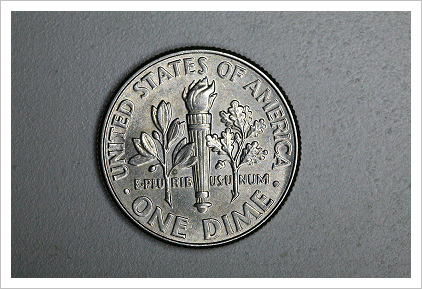
Closest focus (maximum magnification) on a Canon EOS 5D (full frame)
Normal lenses lose sharpness when close focused because the magnitude of various aberrations increases. In a macro lens the lens elements are automatically reconfigured to compensate for the change in aberrations with focusing distance, so full sharpness can be retained even at the closest focusing distance (0.3m in this case) and at 1:1 magnification.
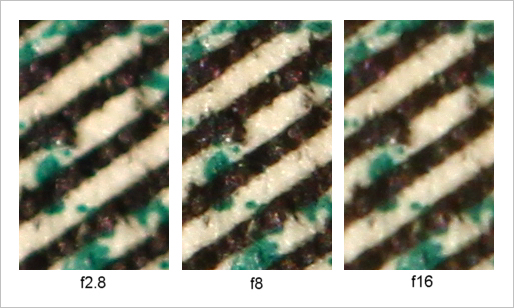
100% crops from image center at 1:1 (banknote target). Canon EOS 7D
The Tamron 90mm f2.8 Di VC USD Macro starts out quite sharp even wide open at 1:1 macro, but it does get better as the lens is stopped down. At f4 it becomes a little sharper and peak sharpness is reached between f5.6 and f8. At f11 you can see very slight softening due to diffraction effects which become more noticable on further stopping down to f16, f22 and f32. For maximum overall sharpness, working in the f8-f11 range is best, with f16 still being pretty good if more DOF is required. f22 is certainly acceptable but diffraction softening becomes quite noticeable at f32 and unless you really need the additional DOF stopping down past f22 isn't really recommended if sharpness is a primary goal. Diffraction softening occurs with all lenses at small apertures of course, so this isn't a criticism of the Tamron lens, just an observation. Note that with ALL lenses DOF also becomes very narrow at 1x magnification. At f2.8 the total DOF is around 1/3mm (0.34mm). Even at f16 the DOF is less than 2mm (1.92mm).
If you want actual numbers I made some measurements using a precision chrome-on-glass target which has resolution patterns down to over 200 lp/mm. Using and EOS 7D and measuring in the center of the frame I saw around 72 lp/mm at f2.8, increasing to about 80 lp/mm at f4 and f5.6. Slight diffraction softening at f8 resulted in a drop to 72 lp/mm which further fell to 64 lp/mm at f11 and 51 lp/mm at f16. For those accustomed to thinking in terms of LPPH (lines per picture height) the peak resolution of 80 lp/mm corresponds to around 2384 LPPH on the EOS 7D. These are very good numbers.
Again the edge sharpness lagged just a little behind the center sharpness, but it peaked around f8 where the edges were pretty close in sharpness to the center.
Distortion
For all practical purposes there isn't any distortion, or to put it another way the distortion was so low that I couldn't get an accurate measurement of it (<0.1%)
Chromatic Aberration
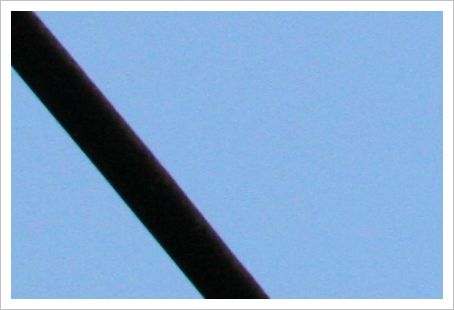
100% crop from extreme corner of image shot with an EOS 5D (full frame)
Chromatic aberration was very well controlled. It was just detectable in the corners of the image but really shouldn't be of any concern. If desired it can easily be corrected using an image editor. The Tamron 90mm f2.8 Di VC USD Macro actually comes with a limited edition version of the Silkypix RAW converter for Tamron which has aberration correction parameters built into it.
Bokeh

Tamron 90mm f2.8 at f2.8 on Canon EOS 7D
The out of focus regions in the images from the Tamron 90mm f2.8 Di VC USD Macro generally seemed quite smooth. This may be helped when stopped down a little by the curved blades of the iris which approximate a circular aperture at wider f-stops.
Vignetting

Tamron 90mm f2.8 Di VC Macro on EOS 5D at f2.8, infinity focus
The Tamron 90mm f2.8 Di VC USD Macro shows some vignetting when used wide open of full frame as would be expected. I measured around 1.6 stop of darkening in the corners at f2.8, around 1 stop at f4 and less than 1/2 stop at f5.6. On a crop sensor this was significantly reduced and I measured about 2/3 stop at f2.8. Stopping down to f4 with an APS-C sensor pretty much eliminated vignetting. Interestingly at 1:1 magnification the frame was essentially uniform with no obvious vignetting.
Lens Speed
Although the Tamron 90mm f2.8 Di VC USD Macro is an f2.8 lens, when focused into the macro region the effective lens speed drops. For example, under a set of conditions which gave an exposure of 1/1000s at f2.8 with the lens focused at infinity, exposure became 1/250s (still with the camera indicating f2.8) when the lens was focused at 0.3m (a magnification of 1x). This indicates about a 2 stop light loss at 1:1 magnification. The camera's exposure system takes care of this automatically of course, so you don't have to worry about it. This is normal behavior for a macro lens.
Conclusions
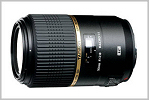 The Tamron SP 90mm f2.8 Di VC USD Macro carries on the tradition of sharp macro lenses from Tamron. Image quality is good from center to edge and the lens is almost as sharp wide open as it is stopped down a stop or two. It's useful both as a macro lens and a general purpose lens which is even quite good for portrait work. The addition of optical stabilization (VC) greatly increases the utility for general purpose handheld shooting. The VC isn't quite so useful at high magnification for the reasons stated above. However to get the best out of any macro lens, especially when shooting stopped down for DOF reasons, a tripod is highly recommended. It makes framing and accurate focusing much easier as well as providing a stable platform for the camera. In that case image stabilization isn't required.
The Tamron SP 90mm f2.8 Di VC USD Macro carries on the tradition of sharp macro lenses from Tamron. Image quality is good from center to edge and the lens is almost as sharp wide open as it is stopped down a stop or two. It's useful both as a macro lens and a general purpose lens which is even quite good for portrait work. The addition of optical stabilization (VC) greatly increases the utility for general purpose handheld shooting. The VC isn't quite so useful at high magnification for the reasons stated above. However to get the best out of any macro lens, especially when shooting stopped down for DOF reasons, a tripod is highly recommended. It makes framing and accurate focusing much easier as well as providing a stable platform for the camera. In that case image stabilization isn't required.
The supplied lens hood and 6 year warranty are also things that you don't get from other lens manufacturers. Some might provide a lens hood, but I think the 6 year warranty is the longest offered by any lens maker.
See the Tamron 90mm f2.8 Di VC USD Macro at AMAZON, ADORAMA and
Alternatives
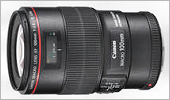 Perhaps the most interesting alternative is the Canon EF 100mm f2.8L IS USM Macro. It's particularly interesting because not only is it a Canon "L" series lens but it has a hybrid IS system. Unlike simpler systems which only compensate for angular rotation of the lens, the hybrid IS system also compensates for horizontal and vertical translation of the lens. It's still not quite as effective at 1:1 macro as it is at longer focus distances, but Canon claim up to 2 stops at 1:1 and up to 4 stops in the non-macro range. The MSPR on the Canon EF 100/2.8L IS USM Macro is currently $1049, but at least for the nest week there is a $150 instant rebate (supposed to end on 4/27/13) making the price $899....but that's not all. ADORAMA is further discounting that price down to $869. That makes it only $120 more than the Tamron lens ($749). I must admit, though the Tamron is a nice lens, an extra $120 for hybrid IS and an "L" series lens doesn't sound like a lot to pay. At the pre-rebate price of $300 more than the Tamron lens the decision would be more difficult. Note though that the Canon lens only has a 1 year warranty but it does come with a hood and soft carrying pouch. An optional tripod ring is also available.
Perhaps the most interesting alternative is the Canon EF 100mm f2.8L IS USM Macro. It's particularly interesting because not only is it a Canon "L" series lens but it has a hybrid IS system. Unlike simpler systems which only compensate for angular rotation of the lens, the hybrid IS system also compensates for horizontal and vertical translation of the lens. It's still not quite as effective at 1:1 macro as it is at longer focus distances, but Canon claim up to 2 stops at 1:1 and up to 4 stops in the non-macro range. The MSPR on the Canon EF 100/2.8L IS USM Macro is currently $1049, but at least for the nest week there is a $150 instant rebate (supposed to end on 4/27/13) making the price $899....but that's not all. ADORAMA is further discounting that price down to $869. That makes it only $120 more than the Tamron lens ($749). I must admit, though the Tamron is a nice lens, an extra $120 for hybrid IS and an "L" series lens doesn't sound like a lot to pay. At the pre-rebate price of $300 more than the Tamron lens the decision would be more difficult. Note though that the Canon lens only has a 1 year warranty but it does come with a hood and soft carrying pouch. An optional tripod ring is also available.
See the Canon 100/2.8L IS USM Macro at AMAZON, ADORAMA and
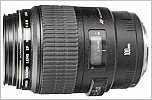 If both the Tamron 90/2.8 Di VC USD Macro and the Canon EF 100/2.8L IS USM Macro are too expensive and you don't need a stabilised lens, there's the excellent Canon 100mm f2.8 Macro USM for around $520-$550 (after the current $50 instant rebate). A very good lens and if you use it mostly for macro work on a tripod or general shooting in good light you may not need the stabilization.
If both the Tamron 90/2.8 Di VC USD Macro and the Canon EF 100/2.8L IS USM Macro are too expensive and you don't need a stabilised lens, there's the excellent Canon 100mm f2.8 Macro USM for around $520-$550 (after the current $50 instant rebate). A very good lens and if you use it mostly for macro work on a tripod or general shooting in good light you may not need the stabilization.
See the Canon 100/2.8 USM Macro at AMAZON, ADORAMA and
